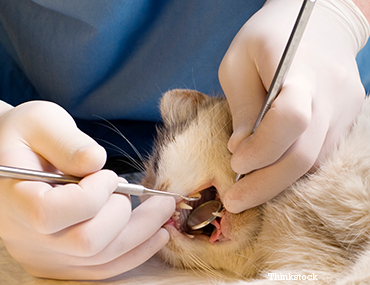
With February being Dental Awareness Month, I thought I would write about feline tooth resorption: one of the most common dental problems affecting cats.
What is tooth resorption?
Historically called feline odontoclastic resorptive lesions (FORL), cervical line lesions, neck lesions, feline caries, cervical line erosions or feline cavities the current term, according to the American Veterinary Dental College, is tooth resorption (TR). TR occurs when cells called odontoclasts destroy the tooth root surfaces by causing the enamel to be resorbed. As the disease progresses, the different layers of the tooth are resorbed and the pulp cavity becomes exposed, causing pain and sensitivity. The resorption continues until the tooth is weakened and ultimately fractures.
What causes tooth resorption?
The cause of these lesions is unknown; no one knows why odontoclastic cells begin to resorb the tooth root. Some researchers believe that infection or inflammation from periodontal disease may lead to the migration of odontoclastic cells into the area. Others believe that diet has a role in causing these lesions.
What cats are at risk of tooth resorption?
All cats can develop feline tooth resorption. In fact it’s one of the most common oral conditions seen in cats. Certain breeds of cats like Siamese, Persians, and Abyssinians appear to be more susceptible to the disease but again any cat can develop these lesions.

Symptoms of tooth resorption
Feline tooth resorptive lesions can cause many issues:
- Pain
- Mouth sensitivity
- Tooth fractures
- Tooth loss
- Anorexia (inappetance)
- Weight loss
Since, these lesions usually start at the gum line, they are often covered with gum tissue or tartar and therefore may be difficult to detect without a thorough oral examination. As the lesions progress you may notice drooling, trouble eating, reluctance to eat or a decrease in appetite and occasionally bloody saliva or swelling around the mouth and jaw.
Diagnosis of tooth resorption
Your veterinarian may identify a feline tooth resorptive lesion while performing an oral exam during your pet’s check-up or during a dental cleaning. Dental radiographs (x-rays) are necessary to properly evaluate the extent of tooth and tooth root damage and determine the appropriate treatment.
Treatment of tooth resorption
The treatment will depend on the lesion and the extent of tooth damage.
Some veterinary dentists will do a restorative treatment (filling) for mildly affected teeth.
Teeth with more damage should be extracted. Since feline tooth resorption is a progressive disease some veterinary dentists feel that extraction is the best option for all affected teeth, even those with mild damage. It is important that people realize these lesions are very painful and simply leaving the affected tooth alone is not an option. If your pet has these lesions your veterinarian will help you determine which treatment option is best for you and your pet.
Prevention of tooth resorption
Without knowing the cause, no one knows exactly how to prevent feline tooth resorption lesions from forming. The best thing you can do is take your cat to the veterinarian regularly so they can prevent periodontal disease, which may be a contributing factor to the formation of feline tooth resorption lesions. In addition your veterinarian will examine your cat for early lesions and treat them before they become advanced and painful. For more information about feline tooth resorption, speak with your veterinarian or visit the American Veterinary Dental College website.
Also check out 10 reasons to care for your pets teeth.
If you have any questions or concerns, you should always visit or call your veterinarian -- they are your best resource to ensure the health and well-being of your pets.
